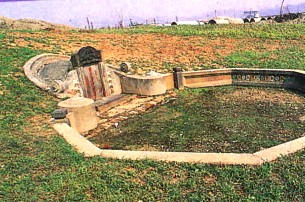Tomb of Lin Xiu-jun
The Taipei Basin was settled and developed at the beginning of the Qing dynasty by a few people from the Zhangzhou and Quanzhou areas of Fujian Province, as well as Guangdong Province. Lin Xiu-jun is considered one of the area’s most important pioneers. Born in 1699, Lin Xiu-jun passed away in 1770 at the age of 72. Hailing from Zhangzhou, he immigrated to Taiwan around the age of 20. After turning 50, he took the name Lin Cheng-zu and devoted himself to developing the area from Baijiebao to Dajia’nabao – what today are Banqiao, Tucheng, Yonghe, Zhonghe and Neihu. The design of his grave follows the traditional southern Fujianese style, with a hill in the center, a carved tombstone in front, and stones on either side. A short, curving wall encircles a broad court in front of the tomb. Built according to the traditional theories of Fengshui, it is one of the very few completely intact large-scale tombs from the Qing era in the Taipei Basin.

![Taiwan.gov.tw [ open a new window]](/images/egov.png)
